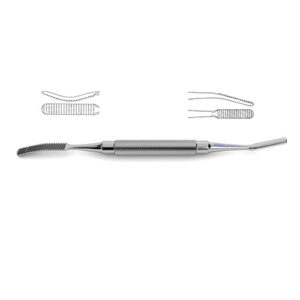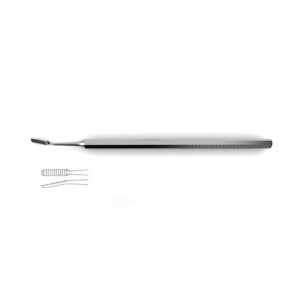| Name | Bone File #10 |
| Lead Time | 0-3 days |
| Competitor | ;MO10056;772007;77-2007;7720-07; |
| Specialty | Neuro, Ortho & Spine-Rasps & Files |
| Material Finish | Stainless Steel |
| Grade | Premium Operating Room |
| Units of Measurement | Each |
| Manufacturer | seemab surgical |
| Sterility | Non-Sterile |
| Usage | Reusable |
Bone File #10
double-ended, plain serrations, 5.0 mm wide ends, 7″ (17.5 cm)?Bone File #10 is a general purpose instrument useful in surgical procedures that require manipulation of bone. This file is double ended making it quick and easy to switch to another unused file without having to switch instrumentation. Each end features plain serrations and is 5.0 mm wide. Additionally this instrument features a slightly textured handle surface that reduces slippage making this instrument ideally suited for a variety of precise neurosurgical procedures.
SKU:
VI-01-1229
Category: Rasps & Files
Description
Shipping & Delivery
Related products
Putti Bone Rasp – Round Blades
round blades, double-ended, 1 10.0 mm round blade tapers to 4.0 mm & 1 15.0 mm half-round blade tapers to 5.0 mm, 12" (30.5 cm)?Putti Bone Rasp is an instrument ideally suited for use in surgeries that require handling and particularly mild reshaping of bone such as in neurosurgical or orthopedic surgeries. . This instrument is double ended and features one round blade and another half round. The unique design of this rasp is in the leap shaped silhouette that tapers from 11.0 mm to 4.0 mm for the round blade and from 15.0 mm to 5.0 for the half round that allows it to be fit into slim and narrow spaces and effectively whittle down bone or hard tissue from any angle.
Bone File #12
double-ended, plain serrations, 7.0 mm & 5.0 mm wide ends, 7" (17.5 cm)?Bone File #12 can be used in a variety of surgical interventions in neurosurgery or orthopedic surgery. This instrument is double ended with each end featuring plain serrations. It is ideally suited for use in filing bones such as reducing a sharp or jagged bone edge to prevent damage to surround tissue or delicate neuro-vascular bundles. Additionally each even here is a different width: 7.0 mm and 5.0 mm making it versatile enough to be used in a number of different surgical scenarios and can satisfy any surgeon preference.
Bone File #45
double-ended, plain serrations, 6.0 mm & 5.0 mm wide ends, 7" (17.5 cm)?Bone File #45 is an instrument crafted for use in neurosurgical orthopedic procedures. It features a hexagonal body that also serves as a grip that makes it easy to handle manually. This file is double ended and features plain serrations as well as two different sized ends: 6.0 mm and 5.0 mm. This instrument can be useful in surgical procedures that require filing or reshaping of bone particularly to prevent damage to surround tissue. Ideally it can be used to protect delicate brain tissue and neurovascular bundles from sharp jagged edges from breaks or from cuts made in surgery.
Miller-Colburn File
double-ended, down-cutting teeth, medium & large ends, octagonal handle, 7-1/4" (18.4 cm)?Miller-Colburn File can be used to soften jagged edges or rough surfaces on bone or other hard surfaces. This file features a slim, octagonal body shaft that doubles as a handle from which two different sizes blade extend on either side. Both ends features down-cutting teeth that allow it to grab hold and uniformly file away at a surface such as the skull or vertebral fragment to protect surrounding tissue from damage in craniotomies or spinal surgeries.
Bone Rasp
bayonet, 1 side flat & 1 side convex w/ cross-serrations, 9-1/2" (24.0 cm)Bone Rasp is designed to aid in manipulation of bone and other hard tissue surfaces. It can be used to scrape or file away at these surfaces to give them a smoother finish for a variety of reasons. Mainly it is well suited for use in neurosurgical or orthopedic surgeries because these coarse bony areas can cause damage to surrounding tissue if they are not evened out with a file or raspatory. This rasp is a bayonet style and features one flat size and one convex side with cross-serrations that makes it well suited for filing.
Bone File – Double-Ended
double-ended, cross-cut, 7" (18.0 cm)?Bone File is a highly versatile instrument that can be used in a vast array of surgical procedures. This file is double ended and is cross cut. The small paddle style blades allow it to be used near delicate tissue areas as are common in neurosurgical procedures and not cause trauma or injury by puncture wound. Additionally use of this file on jagged bone breaks or cuts or even on rough hard surfaces aids in the protected of neurovascular bundles and other tissue layers that are mobilized during surgery that can easily be torn or injured.
Bone File #12A
double-ended, one end plain, other end cross serrated, 5.0 mm wide ends, 7" (17.5 cm)?Bone File #12A is a highly versatile file that can be used in surgical procedures that require manipulation of bone. It is ideally suit for some forms of bone reshaping such as a jagged edge that could endanger the tissue areas around it. In procedures such as craniotomies in which delicate brain tissue is being handled this file aids in keeping the bony area around smooth and free of harmful points. Additionally this instrument is double ended with one end plain and the other cross serrated making it a multi functional file.
Bone File #92B
single-ended, 2.0 mm wide, file inside, backward cutting, angled w/ serrations, 6" (15.0 cm)?Bone File is a highly versatile instrument that can be used in almost any neurosurgical orthopedic procedures. Ranging from craniotomies to spinal surgery this file can be used to file down any types of bone. This can be useful in smoothing down rough edges to prevent catching or tearing of delicate tissues or vasculature during surgical intervention. This instrument is single-ended with the file inside and is angled with serrations and can be used in backward cutting.













